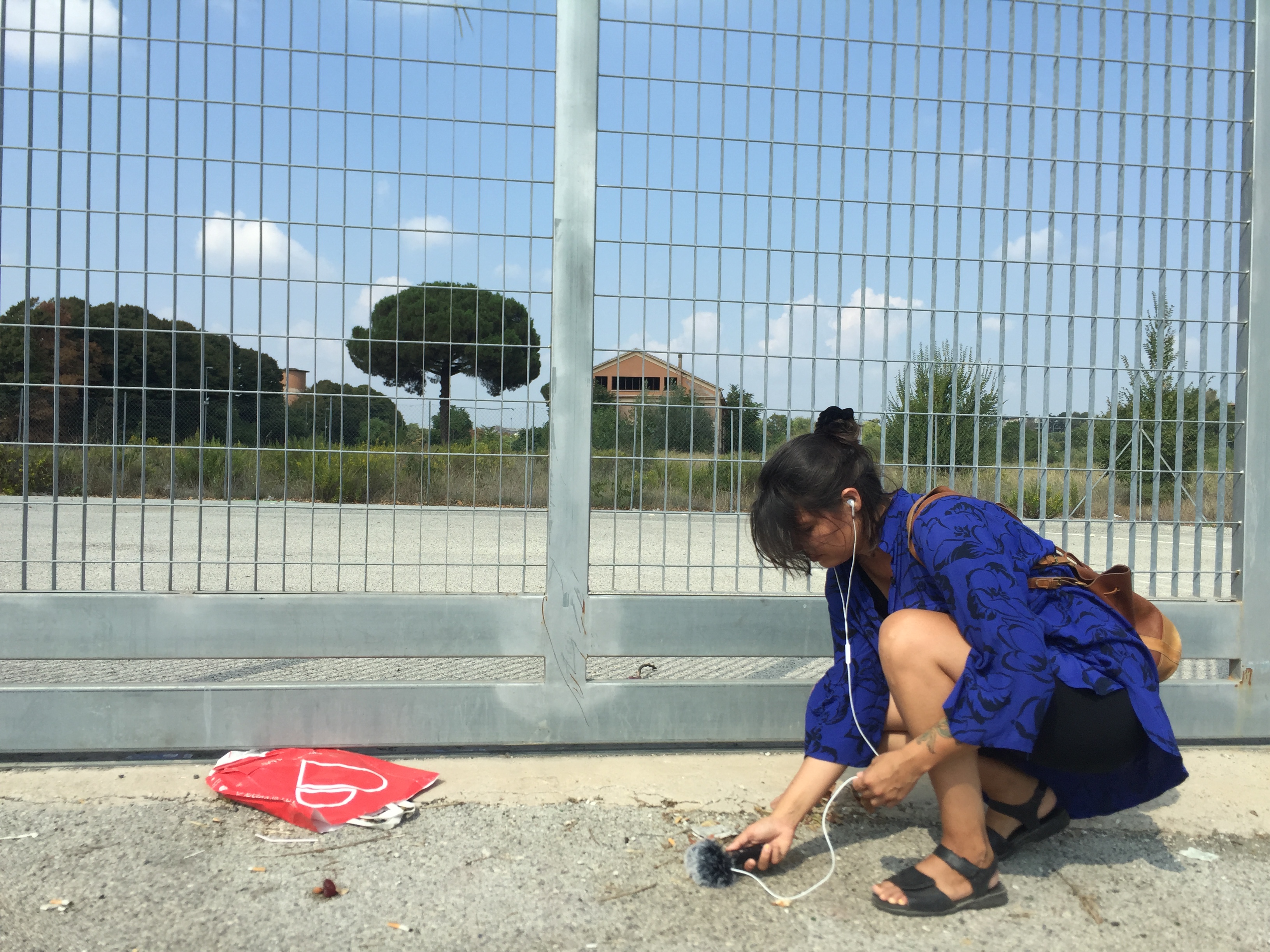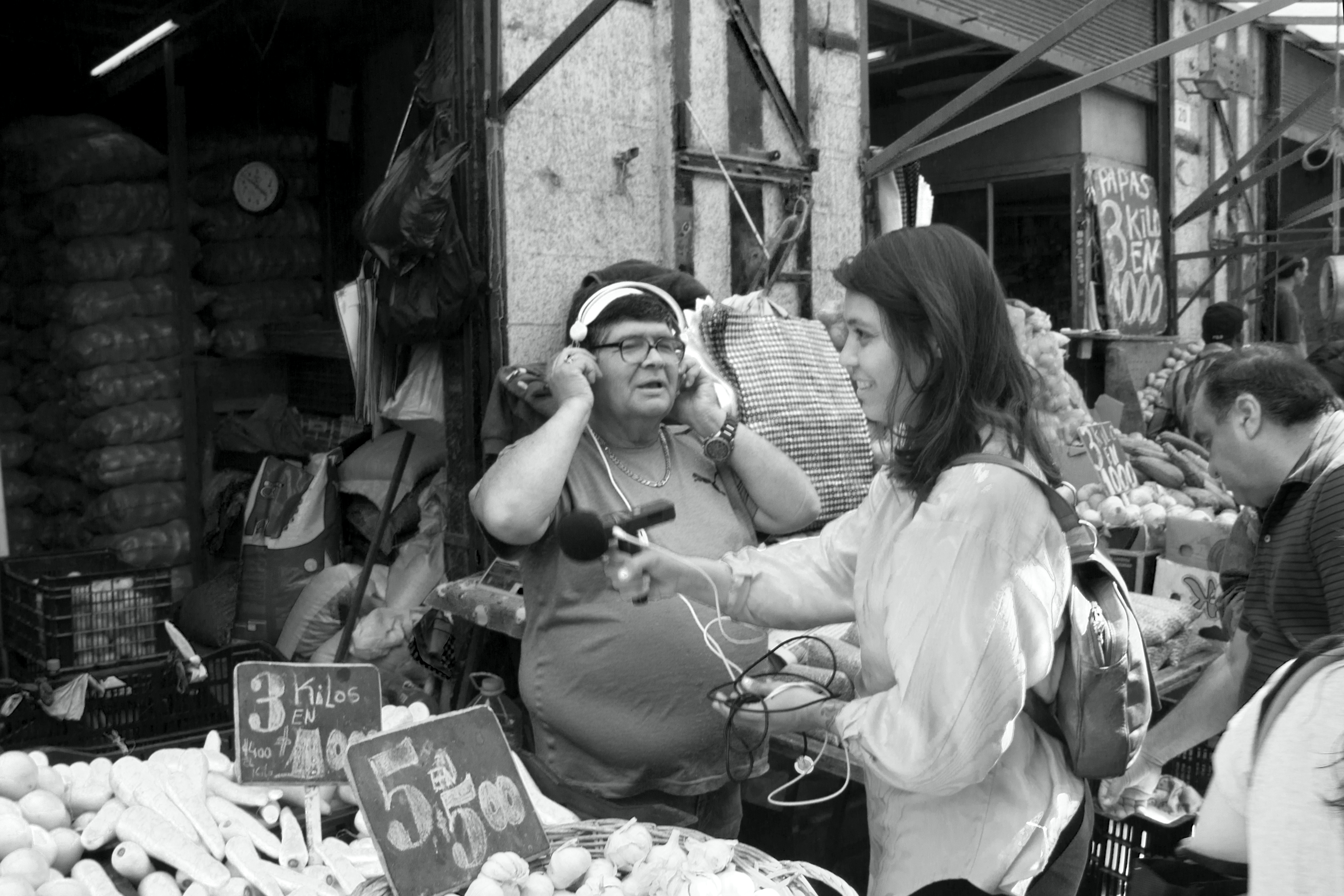Through an open letter to my fellow field inventors, I intend to share my inquiries between ethnographic methods and artistic practices to form new ideas in field devices. I reflect on Sonority as a sonic ethnographic experience and how the sound could shape the path to/in the fieldwork. Following the sonic experience, I explore how sound could contribute to the anthropological Sensory Walking method — sound recording as an artifact of sensory experience and documentation.
Dear field inventors,
I am writing this letter as a kind of communication artifact to openly reflect on my ethnographic and artistic methods experimentations in my ongoing fieldwork. Currently, I am in Chile, in the northern desert part of the country, already in my second fieldwork. I will describe below my ongoing experiments, which embrace Sound and Walking as a way to collect data and as an instrument to reflect on decolonial and postcolonial processes. It has been an interesting journey –the coming and going, the playing, and the testing. These experiments have allowed me to continue a path of transdisciplinarity, which I would like to share with you in more detail in the next paragraph of this letter.
Since September 2021, I have been on the fieldwork(s) journey as part of my current Ph.D. project in the domain of anthropology (Humboldt University of Berlin), looking for different strategies and adapting to the constant uncertainty of making field trips in the context of a global pandemic. My journeys are between Europe and South America (France, Italy, and Chile), making it challenging to adapt and collect data. The different governmental regulations, social contexts, and public health vary from country to country, especially between continents, embodied in the political, economic, and social contradictions between Europe and the others. This letter is part of my ongoing methodological reflections on my Ph.D. project: From spaces of exception/nonplaces to informal settlements/social places through Liminality), which examined three informal camps in Europe and South America: The Dxjangal (so-called The Jungle) in Calais-France, Tiburtina in Rome-Italy and Macro-campamento Los Arenales in Antofagasta-Chile, which were established self-managed by migrants in transit and local NGOs. These migrant communities have transformed deserted and abandoned areas into social places and neighborhoods as part of the city (Massey, 1993).
My professional background is as a visual artist. My artistic format navigates between the object and sound installation as a kind of container and collage at a conceptual and material level. I collect and explore different forms and materials to display stories I encounter in my travels. My past installations connected and overlapped with the ethnographic method empirically and practically. Not only in its concrete forms, such as participatory observation, interviews, and field notes but also as a kind of creative container and a method that could be useful for the creative process itself. Today, this perspective has flipped. Going back and forth between artistic practices and ethnography has given me ongoing reflections on how these two disciplines overlap in their way of observation, description, and analysis. This aspect makes me try to go beyond and see possible artifacts and field devices that converge these two perspectives, which could help in new forms of contemporary research methodologies in social sciences and artistic practices.
Walking | listening sonically | remembering
As a result of border regimes, governmental policies, and the current health crisis due to the Covid-19 pandemic, two of my fieldwork have disappeared (Italy and France). Hence, my first methodological ideas changed drastically, as the communities I was going to research no longer existed as such, remaining ‘ruins’ and deserted spaces within the city. How can I search for the stories of a place that has disappeared? What kind of methodologies is possible for this kind of data collection within ’empty’ spaces?. Inspired by the work methods of the forensic architecture collective, I went to my first fieldwork in Italy in September 2021 in search of Tiburtina; an abandoned building that was taken over by about 800 people, mostly coming from Central Africa, since the 1990s—being the last official eviction in October 2018.
One of my fieldwork’s main elements and instruments involved sound; the collection of soundscapes, sound field notes, recorded sound walks, and collaborative Sonority listening. Containing Deep Listening, expanding the perception of sound in the relationship between space & time. As Pauline Oliveros (2003) argues: “The level of soundscape awareness provided by Deep Listening can lead to the possibility of shaping sound technology and urban environments.” Deep listening within fieldwork and its environment led me to develop the Sonoriting walking device, having three ramifications interconnected with the experience of deep listening through Sonority– inspired by the curator Bonaventure Ndikung’s lectures. Ndikung explores from Arts the notion of deep listening through the creation and understanding of sound spaces. Listening becomes a political act, especially in an era of the omnipresence of images and centralization and monopoly of the visual (Ndikung, 2020). These discourses led me to reflect on deep listening as a decolonial act which will be analyzed in the learnings section of this text.
One of the ramifications consisted of walking hours towards/around the site with my headphones & ZOOM H1n (sound recorder) on at all times[1]. I decided to leave the recorders on because, in general, they (and especially the ZOOM) can amplify the sound you are listening to, making it possible to appreciate the sound textures of the environment delicately. This amplification was my guide while walking —by pointing my recorder at the surrounding area, peculiar sounds were standing out, which motivated me to follow them. Although I had my cell phone with a google map guiding me, the sound I was listening to moved me rhythmically and helped me take small directions of which streets to take towards Tiburtina. These walks mainly were between 10 -17km per day. Sometimes I would take public transportation when I was already tired. But my recorder was always ON.
Walking, listening amplified, and recording. These sensory elements led me to encounter stores, bars, cafes, and squares around the fieldwork. For example, I went into a café near the fieldwork, ordered an espresso, and took out my recorder. Before recording, I explained to the barman about my project and asked for permission to record his voice. I started a conversation with him about migration in the sector and if he knew Tiburtina and its background.

Another situation I experienced was when I walked circularly around Tiburtina; some people stopped by and asked what I was doing. Extraordinarily, I had encounters with people who lived in Tiburtina in 2018, who would tell me about their experience and explain in detail what the infrastructure inside the building was like, with finger-pointing at the communal areas, such as kitchens, bars, dorms, etc. All this from our location of being ‘outside’ the Tiburtina building. These sensory experiences led me to my first approach with the renowned anthropological method, Sensoring walking.
Later I developed a second ramification of the Sonoriting walking device, adding Sonority to the sensory walking. I invited some people I encountered who had lived or volunteered in Tiburtina to walk circularly around the building. During the “circular” walks, they shared experiences and memories of this place, recorded sonically. The initial idea of the third ramification of the device was to get together later with the interviewees, listen to the recording, and comment. Due to mobility restrictions and quarantines in Italy, I could only meet with one volunteer. With him, we sat at a table, placed speakers at our sides, closed our eyes, and actively listened to the recording. Incredibly, a kind of memorial-sound-experience was (re)created. The volunteer heard his own recorded voice as he recounted his memories. This sound experience was transformed into an intimate, sensory space that helped him remember more moments about his work at Tiburtina 10 years ago.
Reflections
Sound has come to have considerable relevance in many disciplines over the last decade; social theorists, historians, literary researchers, musicians, science and technology scholars (Sterne 2003; Thompson 2002, Feld, 2004), and visual, performative, and cultural studies (Oliveros, 2003; Ndikung, 2020). Sound has historically enriched the way we experience reality by providing innovative and experimental modalities for research inside and outside the academy. Steven Feld (1991), one of the pioneers of the anthropology of sound and ethnographies through sound, argues that the sonic experience of knowing and being in the world, which he calls “acoustemology,” experiences Sound from situated knowledge. His ethnographic recordings (one of the most influential was Voices of the Rainforest, 1991) question the meaning of experiencing and feeling like a person living in the place being studied. In one of his early works, in 1972, he questioned the possibility of an anthropology of sound in response to Alan P. Merriam’s (1964) The Anthropology of Music, asking what happens to ethnographies in recordings. Through sound – listening, recording, editing, and representing (Feld, 2004), the anthropology of sound and ethnography turns the sensory perspective of understanding our environment from situated knowledge on its head. Hence, my interest is in continuing to experience Sonority as a field instrument and a possible method of collecting sensory and emotional material within fieldwork. By listening to the field from my positionality with the other (as with the volunteer in Italy). I found relationships between people, place, emotion, and sound, and how the entanglements inside/outside the recordings enrich listening from the perspective of an acoustic ecology (Feld & Brenneis, 2004). I reflect on whether the method of listening in collaboration with each other can sharpen and sensitize a sound experience and, in turn, document the process of sensorial remembering of a place. The sonic experience produced by listening together can create a space/place of critical listening reflection as a kind of active social listening and the development of a deep awareness of the presence and meaning of sound and emotion (Feld, 2004).
I reflect on the possibility of the Sonoroting walking device as an approach to political practices of listening through situated knowledge. I borrow the idea of decolonizing listening from the cultural center and sound residence Tsunami-B.A.S.E. in Valparaíso, Chile. Their line of work focuses on how we listen and whether it is possible to approach the decolonization of listening, and to what extent this can be a liberating experience from the hegemonic power structures that define our ways of listening. Tsunami-B.A.S.E. is not the only cultural space that is questioning this process —many other places in Latin America reflect on the politics of listening and recording from deep listening through experimental sound modalities. Deep and decolonizing listening are possible responses to political acts towards the classical and academic ways of engaging with our surroundings. Re-thinking our ways of capturing the everyday observed within the disciplines of social sciences and arts, allowing go beyond the colonial structures present in these disciplines from their formal, conceptual and aesthetic manner. It opens the problematic of who can listen and who can be listened to, from postcolonial practices on the activation of the other as a political entity in response to the Eurocentric colonial legacy. Here Sonority resonates again, specifically soundscapes and voices of places & people that are outside the centrist matrix of the city, such as my Ph.D. case studies in informal refugee and migrant camps, marginalized places located on the urban ‘periphery’ of the city —I use quotation marks, since from the postcolonial discourse, calling places that are outside the center of the city ‘periphery’ reinforces the colonial structure of marginalization.

How can we record sounds, stories, voices from a decolonial position? Who has the privilege to register and be recorded?. Through the Sonoroting walking device, I intend to explore from collectivity how to capture stories from these ‘peripheral’ places or, more precisely, from these Elsewhere (Chambers, 1995) from a postcolonial discourse. Parallel historie(s) that do not fit in the colonial matrix (Mignolo, 2018) —sharing auditory and sonic experiences, as well stories that have not been told and experiences that have not been heard. I focused on sound and its recording as memory: stories, place, and emotion, and how this memory could produce collective imaginaries and possibilities from decolonial and postcolonial discourse. A sonority is an act of exchange and participation, listening and being listened to. The sensorial formalities that sound converge open another way to knowledge production that does not fit in a visual or written formality (Ndikung, 2021). I am interested in exploring these sensory sound experiences further, using listening together as a kind of sound installation as a format for active listening within the fieldwork. It can also be a device for presenting the collected material to the community. This sonic experience could also be present in artistic spaces such as galleries and cultural centers, which raises the question of how to exhibit ethnographically, being sound a sensory experience that could address this question—occupying installations and exhibitions as a space/place for reflecting anthropologically and a window to the research process itself ( listening a example here)
From my present experimentation in Sonoriting Walking as a methodological artifact for data collection, I understood how ethnography is a method that could embrace further formalities and materialities coming from other disciplines. From a collaborative research approach such as Sonority and listening together, I reflect on whether these elements can contribute to another way of grasping and comprehending the community under study. In my case, it has opened a window into transdisciplinarity as a possible methodological discovery in my ongoing Ph.D. research. I hope my ethnographic-artistic experiments will contribute to the current debate on alternative ways of data collection devices.
HOW TO
It is challenging to leave tips since this device is a game of trials and errors, experimenting, and letting yourself go. As an artist and pseudo anthropologist, I could say that the most important thing for me is to listen symbolically and literally to the field. Symbolically, I am referring to when one is in the field; it is necessary to be flexible and adaptable to every change between the communities and positionalities. For example, in my current scenario, the Omicron virus outbreak has been essential in my strategy change in the field. Daily evaluating the dynamics in the field, taking into account my intuition, is a way of symbolically listening. Literally, I mean listening to the recordings of the day. For example, I had a routine where I listened every night after my day on the field to the recordings I had made that day. I would put on my headphones at night, lay in bed, and listen. Many of them were soundscapes, interviews, walks, and noises. Then the following day, I felt like I had a major inspiration to start writing in my field diary, which has become a collection of short narratives. Doing (in the first instance) the exercise of listening, not making notes or coding, just listening, has helped me (I think) have a better atmospheric and urban representation of the fieldwork captured in my writings.
SOURCES
Carter, P (1992). The Sound in between. Australia: New Endeavor Press.
Chambers, I Edt.(1995). The Postcolonial Question. UK: Routledge.
Erlmann, V (2004). Hearing Cultures: Essays on Sound, Listening and Modernity. London, UK: Routledge.
Feld, S (1991). Voices of the Rainforest. Papua New Guinea: Bosavi Peoples Fund. https://www.voicesoftherainforest.org/
Feld, S, Brenneis, D (2004). Doing anthropology in sound. American Ethnologist. Vol. 31, No. 4 (Nov. 2004), pp. 461-474.
Forensic Architecture (FA) research agency. Goldsmiths: University of London. https://forensic-architecture.org/about/agency
Mignolo, W (2018). On Decoloniality: Concepts, Analytics, Praxis. North Carolina: Duke University Press.
Ndikung, B (2020). Space-Time continuum of Sonority—Deep Listening sessions. Course WS 2020-2021, Raumstrategie MA, Weissensee University Berlin.
Oliveros, P (2005). Deep Listening: A composer’s Sound Practice. iUniverse Press.
Robinson, D (2020). Hungry Listening: Resonant Theory for Indigenous Sound Studies. Cambridge: University Press Monograph Prize.
Tsonami-B.A.S.E, centro cultural y residencia sonora (2021). Semana de la Escucha, decolonizar la escucha. Seminarios online https://www.youtube.com/watch?v=TxMuSxePbLM
Webster, A (2015). The poetry of sound and the sound of poetry: Navajo poetry, phonological iconicity, and linguistic relativity. Semiotica, vol. 2015, no. 207, 2015, pp. 279-301.
NOTES
[1] On at all times, I mean that usually, when you record a sound, the steps to proceed are; to turn on the recorder, record, and then turn it off. In my case, I wasn’t necessarily recording; I just had my recorder on. I could hear what I was “pointing at with my recorder” by having it on. This effect cannot be done with all recorders; the ZOOM has this ability.
